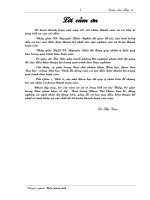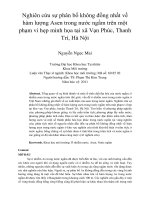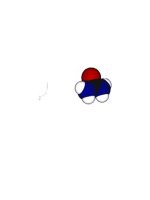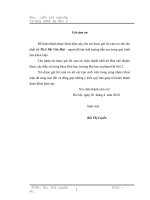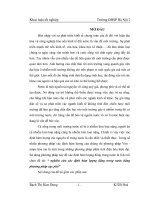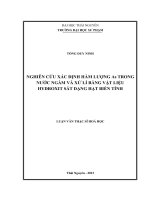xác định hàm lượng asen trong nước ngầm bằng phương pháp lò graphite (bằng tiếng anh)
Bạn đang xem bản rút gọn của tài liệu. Xem và tải ngay bản đầy đủ của tài liệu tại đây (419.75 KB, 39 trang )
Acknowledgment
To my supervisor, Assoc. Prof. Dr. Nguyen Van Ri and
Master. Nguyen Tien Duc in Department of Analysis Chemistry.
I express great appreciation for your time, support patience
and guidance throughout this study your continuous enthusiasm and
knowledge of the topic relating to this project were an inspiration to
me.
Also I am thankful to all my classmates for being great
friends and helping me so much
March, 29
th
, 2012
Doan Thi Bich Ngoc
1
Table of Contents
Abstract (English)
Pollution of arsenic is an acute problem not only in Vietnam but also in
worldwide. It is estimated about 57 million people are using surface
2
water with the arsenic concentration is higher than the World
Health Organization standard of 10 mg / l (ppb). Arsenic in groundwater is of
natural origin and it is released from the sediments due to the
anoxic conditions or from the weathered and runoff ores
containing arsenic. Arsenic is a poisonous compound that can cause some
diseases such as lung cancer, skin cancer, bladder cancer and respiratory
diseases. For this reason, there are many studies to find out the useful
method to reduce arsenic concentrations in water.
In this report, I used the method of atomic absorption
spectrometry with graphite furnace to determine the arsenic levels
in water and study the use of laterite material to absorb arsenic from
water. GF-AAS method is highly sensitive method that can determine the
total arsenic in water with high repeatability and detection limits can be
achieved ppb levels. Using treated laterite as the adsorbent, water
quality is greatly improved, and arsenic can be reduced by 90%, in addition
with the low cost and wide applicability.
3
Abstract (Vietnamese)
Ô nhiễm asen là một vấn đề vô cùng nhức nhối không chỉ ở Việt Nam
mà trên toàn thế giới. Người ta ước tính khoảng 57 triệu người đang sử dụng
nguồn nước mặt có hàm lượng asen cao hơn tiêu chuẩn của Tổ chức Y tế Thế
giới là 10 μg/l (ppb). Asen trong nước mặt có nguồn gốc tự nhiên và nó được
giải phóng ra từ trầm tích do các điều kiện thiếu ôxy hoặc từ các quặng chứa
asen bị phong hóa và rửa trôi. Asen là chất độc có thể gây ra một số loại bệnh
như: ung thư phổi, ung thư da, ung thư bang quang và các bệnh về hô hấp. Vì
lý do đó mà rất nhiều công trình nghiên cứu nhằm tìm ra các phương pháp
hữu ích để làm giảm nồng độ asen trong nước.
Trong bài báo cáo này, tôi đã sử dụng phương pháp quang phổ hấp thụ
nguyên tử với lò graphite để xác định hàm lượng asen trong nước và nghiên
cứu sử dụng đá ong để làm vật liệu hấp thụ asen có trong nước. Phương pháp
GF-AAS là phương pháp có độ nhạy cao, có thể xác định được tổng hàm
lượng asen có trong nước với độ lặp lại cao và giới hạn phát hiện có thể đạt
hàm lượng ppb. Sử dụng đá ong có xử lý làm vật liệu hấp phụ, chất lượng
nước được cải thiện rất nhiều, hàm lượng asen có thể giảm đến 90%, hơn nữa
giá thành rẻ và khả năng ứng dụng rộng rãi.
4
Introduction
In history, arsenic in science, medicine and technology has been
overshadowed by its notoriety as a poison in homicides. Arsenic is viewed as
being synonymous with toxicity. Dangerous arsenic concentrations in natural
waters are now a worldwide problem. High arsenic concentrations have been
reported recently from the USA, China, Chile, Bangladesh, Taiwan, Mexico,
Argentina, Poland, Canada, Hungary, Japan and India. Among them the
largest population at risk is in Bangladesh followed by West Bengal in India.
Twenty one countries in different parts of the word, groundwater contains
arsenic. Many countries in the world are carrying on investigation on arsenic.
Historically, colorimetric and gravimetric methods have been used for
determination of arsenic. In recent years, atomic absorption spectrometry
(AAS) has become the method of choices. However a commonly used
technique for the measurement of arsenic is the highly sensitive hydride
generation atomic absorption spectrometric method. After examine arsenic, if
arsenic is over legal limit in water, those countries must remove arsenic.
There are traditionally technologies to remove arsenic from water (oxidation,
precipitation/coagulation/membrane separation) with far less attention paid to
adsorption. The sorption capacities of both available and developed sorbents
used for arsenic remediation together with the traditional remediation
methods. We have incorporated most of the valuable available literature on
arsenic remediation by adsorption. Existing purification methods for drinking
water; wastewater; industrial effluents, and technological solutions for arsenic
have been listed. Arsenic sorption by commercially available carbons and
other low-cost adsorbents are surveyed and critically reviewed and their
option efficiencies are compared. Some commercially available absorbents
are also surveyed. An extensive table summarizes the sorption capacities of
various adsorbents. Some low-cost adsorbents are superior including treated
slag, carbons developed from agricultural waste (char carbons and coconut
husk carbons), biosorbents (immobilized biomass, orange juice residue),
goethite and some commercial adsorbents, which include resins, gels, silica,
treated silica tested for arsenic removal come out to be superior. Desorption
5
of arsenic followed by regeneration of sorbents has been discussed. Strong
acids and bases seem to be the best desorbing agents to produce arsenic
concentrates. Arsenic concentrate treatment and disposal obtained is briefly
addressed. This issue is very important but much less discussed.
A: Overview of arsenic
Chapter 1: Introducing arsenic
1.1 Properties of arsenic
1.1.1 Identity
Elemental arsenic (As) is a member of Group 15 of the periodic table,
with nitrogen, phosphorus, antimony and bismuth. It has an atomic number of
33 and an atomic mass of 74.91.
Arsenic is ubiquitous and ranks 20th in natural abundance, comprising
about 0.00005% of the earth’s crust, 14th in the seawater, and 12th in the
human body. It’s concentration in most rocks ranges from 0.5 to 2.5 mg/kg,
though higher concentrations are found in finer grained argillaceous
sediments and phosphorites. It is a silver-grey brittle crystalline solid, specific
gravity 5.73, melting point 817
o
C (at 28 atm), boiling point 613
o
C and vapor
pressure 1mm Hg at 372
o
C
1.1.2 Chemical and physical properties of arsenic compounds
Arsenic is a metalloid widely distributed in the earth’s crust. It can exist
in four valency states; –3, 0, +3, and +5. In strongly reducing environments,
elemental arsenic and arsine (–3) can exist. Under moderately reducing
conditions, arsenite (+3) may be the dominant form, but arsenate (+5) is
generally the stable oxidation state in oxygenated environments.
Environmental forms include arsenious acids (H
3
AsO
3
, H
3
AsO
3
,
H
3
AsO
3
2-
), arsenic acids (H
3
AsO
4
, H
3
AsO
4
-
, H
3
AsO
4
2-
), arsenites, arsenates,
methyl arsenic acid, dimethylarsinic acid, arsine, etc. Arsenic (III) is a hard
acid and preferentially complexes with oxides and nitrogen. Conversely,
arsenic (V) behaves like a soft acid, forming complexes with sulfides.
6
Inorganic forms of arsenic most often exist in water supplies. Arsenic is
uniquely sensitive to mobilization (pH 6.5–8.5) and under both oxidizing and
reducing conditions among heavy metalloids. Two forms are common in
natural waters: arsenite (AsO
3
3-
) and arsenate (AsO
4
3-
), referred to as arsenic
(III) and arsenic (V). Pentavalent (+5) or arsenate species are AsO
4
3-
,
HAsO
4
2
-, H
2
AsO
4
-while trivalent (+3) arsenates include As(OH)
3
, As(OH)
4
-
,
AsO
2
OH
2
-
and AsO
3
3-
.
1.2 Arsenic and water
Arsenic can be found in seawater (2-4 ppb), and in rivers (0.5-2 ppb).
Half of the arsenic present is bound to particles. Freshwater and seas algae
contain about 1-250 ppm of arsenic, freshwater hydrophytes contain 2-1450
ppm, marine mollusks contain 1-70 ppm, marine crustaceans 0.5-69 ppm, and
fishes 0.2-320 ppm (all values are based on dry mass). In some marine
organisms, such as algae and shrimp, arsenic can be found in organic
compounds.[1]
The legal limit for arsenic in water applied by the World Health
Organization (WHO) is 10 µg/L.
1.2.1 Arsenic react with water
Elementary arsenic normally does not react with water in absence of
air. It does not react with dry air, but when it comes in contact with moist air a
layer is formed. The layer has a bronze color, and later develops a black
surface. An example of an arsenic compounds that reacts strongly with water
is orpiment. This is an amorphous arsenic compound. Reaction mechanism:
As
2
S
3
+ 6 H
2
O → 2 H
3
AsO
3
+ 3 H
2
S
In natural water arsenic participates in oxidation and reduction reactions,
coagulation and adsorption. Adsorption of arsenic to fine particles in water
and precipitation with aluminum or iron hydroxides causes arsenic to enter
sediments.
1.2.2 Arsenic present in water
Metallic arsenic is processed in lead or copper alloys, to increase
hardness. The extremely toxic arsenic gas ASH
3
plays an important role in
microchip production. Copper arsenate (Cu
3
(AsO
4
)
2
.4H
2
O) is applied as a
pesticide in viticulture, but its use is currently prohibited in many countries.
Paxite (CuAs
2
) is an insecticide and fungicide.
7
1.3 Effect of arsenic
1.3.1 The environmental effects of arsenic in water
Arsenic is an essential compound for many animal species, because it
plays a role in protein synthesis. It is unclear whether arsenic is a dietary
mineral for humans. Arsenic toxicity is another important characteristic. The
boundary concentration of arsenic is 2-46 ppm for freshwater algae.
Plants absorb arsenic fairly easily, so that high-ranking concentrations may be
present in food. The concentrations of the dangerous inorganic arsenics that
are currently present in surface waters enhance the chances of alteration of
genetic materials of fish.
1.3.2 The health effects of arsenic in water
Arsenic related illness is usually caused by consumption of
contaminated drinking water. In the old days it was applied as a poison,
because symptoms of arsenic poisoning resemble cholera symptoms, and
therefore the intentional factor was shaded.
Arsenic in drinking water is an issue of global importance; therefore the
legal limit was decreased to 10μg /L. This legal limit is not met in countries
such as Vietnam and Bangladesh, where millions of people consume drinking
water with an arsenic content of over 50μg /L. This problem results in long-
term chronic health effects, such as skin disease, skin cancer, and tumors in
lungs, bladder, kidneys and liver.
1.3.3 Arsenic contamination of water in the world
Arsenic in natural waters is a worldwide problem. Arsenic pollution has
been reported recently in the USA, China, Bangladesh, Taiwan, Mexico,
Argentina, Poland, Canada, Hungary, New Zealand, Japan, and India. The
largest population with known groundwater arsenic contamination is in
Bangladesh, followed by West Bengal in India. Larger regions in the USA are
affected. Vulnerable areas in Nepal, Pakistan, Thai-land, Laos, Cambodia,
and Sumatra have barely or not been examined so far. Many other countries
and districts in South East Asia, such as Vietnam, Cambodia, and China have
geological environments conducive to generation of high-arsenic
groundwater.
8
1.3.3.1 At Bangladesh and West Bengal
According to the World Health Organization, “In Bangladesh, West
Bengal (India) and some other areas, most drinking-water used to be collected
from open dug wells and ponds with little or no arsenic, but with
contaminated water transmitting diseases such as diarrhea, dysentery, typhoid,
cholera and hepatitis. Programmes to provide ‘safe’ drinking-water over the
past 30 years have helped to control these diseases, but in some areas they
have had the unexpected side-effect of exposing the population to another
health problem—arsenic.” The acceptable level as defined by WHO for
maximum concentrations of arsenic in safe drinking water is 0.01 mg/L. The
Bangladesh government's standard is at a slightly higher rate, at 0.05 mg/L
being considered safe. WHO has defined the areas under threat: Seven of the
nineteen districts of West Bengal have been reported to have ground water
arsenic concentrations above 0.05 mg/L. The total population in these seven
districts is over 34 million, with the number using arsenic-rich water is more
than 1 million (above 0.05 mg/L). That number increases to 1.3 million when
the concentration is above 0.01 mg/L. According to a British Geological
Survey study in 1998 on shallow tube-wells in 61 of the 64 districts in
Bangladesh, 46% of the samples were above 0.01 mg/L and 27% were above
0.050 mg/L. When combined with the estimated 1999 population, it was
estimated that the number of people exposed to arsenic concentrations above
0.05 mg/L is 28-35 million and the number of those exposed to more than
0.01 mg/L is 46-57 million. [2]
1.3.3.2 United States
There are many locations across the United States where the
groundwater contains naturally high concentrations of arsenic. Cases of
groundwater-caused acute arsenic toxicity, such as those found in
Bangladesh, are unknown in the United States where the concern has focused
on the role of arsenic as a carcinogen
Some locations in the United States, such as Fallon, Nevada, have long
been known to have groundwater with relatively high arsenic concentrations
(in excess of 0.08 mg/L). Even some surface waters, such as the Verde River
in Arizona, sometimes exceed 0.01 mg/L arsenic, especially during low-flow
periods when the river flow is dominated by groundwater discharge. [3]
9
1.3.4 Arsenic contamination of water in Vietnam
Arsenic contamination of water has become a crucial water quality
problem in many part of the world. The contamination of groundwater by
arsenic in Bangladesh is the largest poisoning of a population in history. At
Vietnam the Vietnamese capital of Hanoi is situated at the upper end of the 11
000 km2 Red River Delta of northern Vietnam, which is inhabited by 11
million people and is one of the most populous areas in the world. Together
with the Mekong Delta, the Red River Delta (Bac Bo Plain) has become one
of the most productive agricultural regions of Southeast Asia. The rural
population is growing rapidly and has, in the last 5-7 yr, moved away from
using surface water or water from shallow dug wells as sources for drinking
water in favor of groundwater pumped from individual private (family based)
tube wells. Groundwater exploitation in the city of Hanoi began 90 yr ago.
Today, eight major well fields supply water to city treatment facilities, which
process 500 000m3 of water per day. [4-6]
The results of the measuring campaign of September 1999 in the rural
districts. The results from the investigated family-based tube wells reveal that
50% of the samples exceed the Vietnamese guideline value of 50 µg arsenic
per liter with an average concentration of all the samples amounting to 159 µg
/l. Peak values of 3000 µg arsenic per liter, south of Hanoi. The situation in a
district (peak value of arsenic in water) is particularly alarming: with an
average value of 432 µg /l, 90% of the analyzed samples revealed
concentrations of 51– 3000 µg /l.
10
Chapter 2: Analytical arsenic
Historically, colorimetric and gravimetric methods have been used for
the determination of arsenic. However, these methods are either semi-
quantitative or lack sensitivity. In recent years, atomic absorption
spectrometry (AAS) has become the method of choice, as it offers the
possibility of selectivity and sensitivity in the detection of a wide range of
metals and non-metals including arsenic. Popular methods for generating
atoms for AAS are flame and electrothermally heated graphite furnaces.
However, a commonly used technique for the measurement of arsenic is the
highly sensitive hydride generation atomic absorption spectrometric method
(HGAAS). However, although it is suitable for total arsenic determination
after appropriate digestion the technique is only routinely used to speciate a
limited number of compounds – arsenite, arsenate, MMA, DMA,
trimethylarsine oxide (TMAO).
2.1 Sample preparation and treatment
2.1.1 Sampling and collection
Care must be taken to avoid contamination and prevent speciation
changes during sample collection and storage. Plastic containers should be
acid washed and traces of oxidizing and reducing agents avoided to preserve
the oxidation state of arsenic compounds
2.1.2 Oxidative digestion
Acid digestion and dry ashing are the two basic methods which have
been widely employed for oxidative digestion of samples before analysis. In
more recent years, microwave-assisted digestion has been used. For analysis
of biological soft tissues by ICP techniques, a simple partial digestion in a
closed vessel at low temperature and pressure is often sufficient for the
sample preparation and pretreatment step.
2.1.3 Extraction
For speciation of arsenic, solvent extraction is often required before
analysis. For example, arsenite and arsenate in soil can be speciated after a
hydrochloric acid and chloroform extraction procedure. Water has been used
11
for the extraction of soluble arsenic compounds from soil with the aid of
ultrasonic treatment
2.1.4 Supercritical fluid extraction
There are very few publications on the use of supercritical fluid
extraction (SFE) for the determination of arsenic. Wenclawiak & Krah (1995)
reported a procedure for the measurement of arsenic species using SFE
followed by GC or SFC detection.
2.2 Macro-measurement
Most procedures for the separation and determination of arsenic are
based on distillation and hydrogen sulfide precipitation methods. Beard &
Lyerly (1961) reported a gravimetric method for the measurement of arsenic
following extraction of arsenic as AsCl
3
by benzene in strong hydrochloric
acid. The recovery was close to 100% when 20 mg was spiked into an
aqueous solution.
2.3 Colorimetric methods
George et al. (1973) carried out a collaborative study for a colorimetric
measurement of arsenic in poultry and swine tissues using silver
diethyldithiocarbamate (AgDDTC) as the complexion agent. The sensitivity
was 0.1 mg/kg in tissues. Dhar et al. (1997) reported a detection limit of 0.04
mg/liter with 95% confidence limit using AgDDTC in chloroform with
hexamethylenetetramine.
2.4 Methods for total inorganic arsenic
Methods for the analysis of inorganic arsenic based on its conversion to
arsenic trichloride or arsenic tribromide by treatment with 6 mol/liter
hydrochloric acid or hydrobromic acid have been described. The arsenic
trihalide is separated from the remaining organic arsenic either by distillation
(Maher, 1983) or by solvent extraction (Brooke & Evans, 1981). The methods
have been applied routinely to the measurement of inorganic arsenic in a
variety of foodstuffs, including those of marine origin where any inorganic
arsenic is a small percentage of the total arsenic present
12
2.5 Atomic spectrometry
Common flame atomic absorption spectrometric methods are flame
AAS (FAAS), electrothermal AAS (ETAAS) and hydride generation AAS
(HGAAS). FAAS is relatively less sensitive for the determination of arsenic
than ETAAS and HGAAS. Its detection limit is usually in the range of sub-
milligram quantities per liter, and therefore it has limited application,
especially for biological samples.
HGAAS is probably the most widely used method for the
determination of arsenic in various matrices. Most of the reported errors in the
determination of arsenic by HGAAS with NaBH
4
can be attributed to
variation in the production of the hydride and its transport into the atomizer.
The reaction and atomization of arsine have been reviewed and discussed by
Welz et al. (1990). The addition of a solution of l-cysteine to a sample before
hydride generation eliminates interference by a number of transition metals in
the generation of arsine from arsenite and arsenate, and improves responses of
arsine generated from MMA and DMA in the presence of arsenite and
arsenate.
Atomic fluorescence spectrometry (AFS) has recently been used for the
detection of arsenic hydrides in the ultraviolet spectral region because of the
small background emission produced by the relatively cool hydrogen
diffusion flame. The use of cold vapor or hydride generation, together with
intense light sources, allows very low detection limits to be achieved. For
example, arsenic species in seawater have been measured using hydride
generation and cold trapping, coupled with AFS detection at 193.7 nm. They
found detection limits of 2.3, 0.9, 2.4 and 3.7 ng/liter for arsenite, arsenate,
MMA and DMA respectively (in a 5 ml sample), with a precision of 3.5%.
2.6 ICP methodologies
ICP-MS is more susceptible to isobaric interferences arising from the
plasma. For example, hydrochloric acid and perchloric acid are not desirable
for sample preparation, because the chloride ions generated in the plasma
combine with the argon gas to form argon chloride (ArCl). This has the same
mass as arsenic (75) which could lead to error if not corrected. Therefore,
whenever possible, only nitric acid should be used in sample preparation.
13
2.7 Voltammetry
Voltammetric stripping methods are mostly based on the chemical
reduction of As (V) to As (III) before the deposition step, because it has been
generally assumed that As (V) is electrochemically inactive. Mercury and
gold (or gold-plated) electrodes are most commonly used for the
determination of arsenic.
2.8 X-ray spectroscopy
Particle-induced X-ray emission spectrometry (PIXES) is an analytical
technique that entails the bombardment of a sample (target) with charged
particles, resulting in the emission of characteristic X-rays of the elements
present. PIXES is a multi-elemental technique with a detection limit of
approximately 0.1 μg As/g. It has the advantage of using small samples (1 mg
or less) and being a non-destructive technique.
14
Chapter 3: Arsenic remediation
There are several methods available for removal of arsenic from water
in large conventional treatment plants. The most commonly used technologies
include oxidation, co-precipitation and adsorption onto coagulated flocs, lime
treatment, adsorption onto sorptive media, ion exchange resin and membrane
techniques. A detailed review of arsenic removal technologies is presented by
Sorg and Logsdon (1978). Jackel (1994) has documented several advances in
arsenic removal technologies. In view of the lowering the drinking water
standards by USEPA, a review of arsenic removal technologies was made to
consider the economic factors involved in implementing lower drinking water
standards for arsenic. Many of the arsenic removal technologies have been
discussed in details in AWWA reference book. A comprehensive review of
low-cost, well-water treatment technologies for arsenic removal with the list
of companies and organizations involved in arsenic removal technologies has
been compiled by Murcott (2000) with contact detail.[8]
15
[9-10]
16
3.1 Co-precipitation and adsorption processes
Water treatment with coagulants such as aluminum alum,
Al
2
(SO
4
)
3
.18H
2
O, ferric chloride , FeCl
3
and ferric sulfate Fe
2
(SO
4
)
3
.7H
2
O are
effective in removing arsenic from water. Ferric salts have been found to be
more effective in removing arsenic than alum on a weight basis and effective
over a wider range of pH. In both cases pentavalent arsenic can be more
effectively removed than trivalent arsenic. In the coagulation-flocculation
process aluminum sulfate, or ferric chloride, or ferric sulfate is added and
dissolved in water under efficient stirring for one to few minutes. Aluminium
or ferric hydroxide micro-flocs are formed rapidly. The water is then gently
stirred for few minutes for agglomeration of micro-flocs into larger easily
settable flocs. During this flocculation process all kinds of microparticles and
negatively charged ions are attached to the flocs by electrostatic attachment.
Arsenic is also adsorbed onto coagualted flocs. As trivalent arsenic occurs in
non-ionized form, it is not subject to significant removal. Oxidation of As(III)
to As(V) is thus required as a pretreatment for efficient removal. This can be
achieved by addition of bleaching powder (chlorine) or potassium
permanganate as shown in Equations 2 and 3. The possible chemical
equations of alum coagulation are as follows: Alum dissolution:
Al
2
(SO4)
3
.18H2O = 2Al
3+
+ 3SO4
2-
+ 18H
2
O (1)
Aluminium precipitation(acidic):
2Al
3+
+ 6H
2
O = 2Al(OH)
3
+ 6H
+
(2)
Co-precipitation (Non-stoichiometric, non-defined product):
H
2
AsO
4
-
+ Al(OH)
3
= Al-As (complex) + Other Products (3)
Arsenic adsorbed on aluminiun hydroxide focs as Al-As complex is removed
by sedimentation. Filtration may be required to ensure complete removal of
all flocs. Similar reactions take place in case of ferric chloride and ferric
sulfate with the formation of Fe-As complex as end product which is removed
by the process of sedimentation and filtration. The possible reactions of
arsenate with hydrous iron oxide are shown below where [≡FeOH
o
] represents
oxide surface site
Fe(OH)
3
(s) + H
3
AsO
4
→ FeAsO
4
.2H
2
O + H
2
O (4)
≡FeOH
o
+ AsO
4
3-
+ 3 H
+
→ ≡FeH
2
AsO
4
+ H
2
O (5)
17
≡FeOH
o
+ AsO
4
3-
+ 2 H
+
→ ≡FeHAsO
4
-
+ H
2
O (6)
The immobilization of arsenic by hydrous iron oxide, as shown in Eqs. 4 to 6,
requires oxidation of arsenic species into As(V) form for higher efficiency.
Arsenic removal is dependent on pH. In alum coagulation, the removal is
most effective in the pH range 7.2-7.5 and in iron coagulation, efficient
removal is achieved in a wider pH range usually between 6.0 and 8.5 [11].
3.2 Arsenic removal by adsorption onto Fe hydroxide and oxidation by
hypochlorite.
The use of naturally occurring iron precipitates in ground water in
Bangladesh is a promising method of removing arsenic by adsorption. It has
been found that hand tubewell water in 65% of the area in Bangladesh
contains iron in excess of 2 mg/L and in many acute iron problem areas, the
concentration of dissolved iron is higher than 15 mg/L. Although no good
correlation between concentrations of iron and arsenic has been derived, iron
and arsenic have been found to co-exist in ground water. Most of the tubewell
water samples satisfying Bangladesh Drinking Water Standard for Iron ( 1
mg/L) also satisfy the standard for Arsenic (50 mg/L). Only about 50% of the
samples having iron content 1 - 5 mg/L satisfy the standard for arsenic while
75% of the samples having iron content > 5 mg/L are unsafe for having high
concentration of arsenic. The iron precipitates [Fe(OH)
3
] formed by oxidation
of dissolved iron [Fe(OH)
2
] present in groundwater, as discussed above, have
the affinity for the adsorption of arsenic. The Fe-As removal relationship with
good correlation in some operating IRPs has been plotted in Figure 4. Results
show that most IRPs can lower arsenic content of tubewell water to half to
one-fifth of the original concentrations. The efficiency of these community
type Fe-As removal plant can be increased by increasing the contact time
between arsenic species and iron flocs. Community participation in operation
and maintenance in the local level is absolutely essential for effective use of
these plants.[12]
18
B: Experimental Results
Chapter 1: Determination of arsenic content in natural water by
graphite furnace atomic absorption spectrometry.
Atomic absorption spectrometry (AAS) is an easy, rapid method and
has been widely used for the determination of trace elements in natural water.
However, it has not been used for direct determination of As because of poor
sensitivity. The sensitivity is greatly enhanced by coupling a hydride
generation method with flame [14] and flameless [15] atomic absorption
spectrometry. Walcerz et al. [16] and Sturgeon and Gregoire [17] reported
unique preconcentration methods. That is, generated hydrides were
transferred to the inner wall of the graphite furnace, then the furnace was
heated at a high temperature, vaporized As was determined by AAS [18] and
ICP-MS [19]. However, the hydride generation method has a tendency to
interference by coexisting ions [20]
1 Reagents and apparatus
1.1 Reagents
- Axid: HCl PA-Merck 36%
HNO
3
PA-Merck 65%
H
2
SO
4
PA-Merck
- The solutions of chemical modified
Pd(NO
3
)
2
Merck 10.000ppm
Mg(NO
3
)
2
Merck 1000ppm
Ni(NO
3
)
2
Merck 1000ppm
- Twice distilled water
- Standard solution As 1000ppm for AAS, Merck
1.2 Apparatus
• Atomic absorption spectroscopy (AAS)
1. Device Name: Atomic Absorption Spectrophotometer (AAS)
2. Marking: AA - 6800
19
3. Manufacturer: Shimazdu - Japan
4. Panorama photo equipment
5. The main technical parameters
5.1. AA-6800F Main Unit
+The body can pair the more other systems
+ Includes: monochromatic radiation sources, Division of samples, optical
systems and electronic systems, unit measure signaling interfacing with
computer controlled Wizard software
+ Being able to switch automatically measuring techniques to measure
furnace flame and graphite
5.2. The system is GFA-EX7 graphite
+ Furnace system, the power supply line, accompanied by accessories:
cuvette graphite, graphite electrodes,
5.3. Automatic samplers ASC-6100
+ Can be used to increase automation for all measurement techniques:
flame, furnace measurements, measuring hydride, measurement of cold
air
+ Can not use that measure by hand.
5.4. Ministry of HVG hydride -1
+ Includes main unit, quartz cuvette, mixer, loop response, the
separation of liquid and air nozzle connected to form the ASC-6100
+ To measure the ability to create the element hydrides: As, Se, Hg,
5.5. Ministry of cold MVU-1A
+ Includes main unit, reactor, the stirring words, the circulating gas and
sealed cuvette.
+ Hg measured with high sensitivity of 0.1 ppb
5.6. Gas supply system
+ Clean air compressor OF-25B
+ The system gas: C
2
H
2,
N
2
O, Ar.
5.7.Bo hollow cathode lamps (HCL) and add the D
2
lamp:
+ Includes 10 lights HCL: Cd, Co, Cr, Fe, Mn, Ni, Pb, Zn, Ca, Mg
+ Lights add the background spectrum measured D
2
5.8. Working conditions of the system:
Voltage: Single Phase (220 ± 10%). Particularly the MVU-1A must use
100V voltage
Temperature: 20 -25
o
C. Humidity: Maintain 80%.
+ Cooling water to furnace: Temperatures below 55
o
C.
6. Operating principle
20
Theoretical basis of the AAS measurement is the absorption of energy
(monochromatic radiation) of free atoms in a state of steam (gas) when the
projection beam of radiation through the vapor cloud elements in the
environment that absorbed . So you want to do is measure the atomic
absorption spectrum should have the following processes:
+ choose a type conditions and appropriate equipment to transfer
samples for analysis from the initial state (solid or liquid) into a vapor state of
free atoms. It is the process of sample atoms. The equipment to perform this
process called chemical model of atomic systems.
+ Screening of a light beam emitted by the element to be analyzed
through atomic vapor cloud has been prepared above. The atoms of the
element to determine the vapor cloud would absorb the radiation and produce
certain of its absorption spectrum. Here, a beam intensity of a light had been
absorbed by atoms and depends on the concentration of elements in the
environment to absorb. Source emitting a light beam to determine the
elements called monochromatic radiation source.
AAS 6800 + atoms can form chemical flame or no flame (using
graphite furnace) has very high sensitivity when to fold hundreds of
thousands of times in the flame measurements should be able to identify the
elements traces with very small concentrations.
7. The parameters of the model that the device can be measured:
Concentrations of heavy metals such as (Cu, Pb, Zn, Cd, Hg, As, B, Cr, Al,
Fe, Ni, ) the alkali and alkaline earth metals (Ca, Mg, K, Na ) have
environmental components in soil, water, air, fertilizer and agricultural
products.
9. Basic requirements for sample: Most of all in solid form (to be
destroyed by the microwave), liquid, gas (to be absorbed in the solution and
then measuring machine)
* Electric flask heater 250ml
* Volumetric flask 10ml, 25ml, 50ml, 100ml, 250ml
* Pipette 1ml, 2ml, 5ml, 10ml…… micropipette 20-5000µl
21
Test condition
HCL light (mA) 10 (70% I
Max
)
Measure bar (nm) 309,30
Slot meter (nm) 0,5
Height measurement
(mm)
6-7
Environment gas
(mL/ph)
Ar
Type of cuvet A
Environment of sample
solution
HNO
3
2%
Background sample
(Modify)
0,05 mg/ml Mg(NO
3
)
2
Loading of sample ( µL)
10
Sensitivity LOD (ppb) 0,5
Linear region(ppb) 2 – 30
Atomization program T(
o
C) t(s)
T
Ram
(s)
Ar(ml/ph)
1: Dry 120/250 30 30 500-400
2: Cineration 600/700 30 15 800-1000
3:Atomization
spectrometry
2550/2600 3 0 30
4: Clean cuvet 2700 2 0 1000
Analysis of spectral lines
22
No Spectral line
(nm)
LOD (ppb) LOQ (ppb) C
Max
(ppb)
1 As-193,70 0.2 2 20
2 Survey the conditions of spectrometry.
To study a good result, the study selected parameters measured in accordance
with a quantitative analysis of chemical elements is a work essential and
important in AAS techniques.
Preliminary survey we chose the following conditions to conduct optimal
machine parameters:
- Solution As: 50ppb in HNO
3
0.5%, modified Pd(NO
3
)
2
0.03%
- Volume of each pumping: 20μl
- Measuring mode: absorbance ( Abs)
2.1 Select the measurement wavelength
Atoms of each element can only absorb the spectrum having characteristic
energy, emitted in the emission process. Absorbance spectrum of atoms is line
spectrum. With each element have a several lines to the characteristic
emission spectra. Therefore, the selected lines which not only makes sense to
find a spectrum with highest absorption but also must be compatible with the
purposes of research and avoid the crowded spectra of other elements having
a wavelength coincides with wavelength of the element to be analyzed.
Results of the scientist showed that arsenic has two characteristic lines are
193.7nm and 228.8nm, 228.8nm in wavelength photosynthesis absorption of
arsenic is affected by spectral lines of the elements cadmium, photosynthesis
absorption is peak at a wavelength of 193.7nm. We therefore choose to
measure arsenic at 193.7nm spectral lines.
2.2 Survey intensity hollow cathode lamps
Hollow cathode lamps (HCL) is the source of resonance radiation, it emits
sensitive radiation beams of metal element is used as the cathode hollow.
HCL lamps work in a given regime of the radiation beam will have certain
intensity. The intensity working of HCL lamp has related to the intensity
23
absorption of spectral lines. Current working of the lamp of each element
HCL is very different. Each lamp HCL has limited the maximum current
(I
max
) is written in shell lamps. The theoretical and experimental analysis of
the atomic absorption spectrum, the intensity should be used only in limited
range of 60-85% of maximum intensity lamp. If the maximum used will be
very quickly broken lamp, lamp working instability, and sensitivity,
repeatability is poor. With the HCL lamp of arsenic have I max = 12mA, we
examined the lamp intensity value: 6; 7; 8; 9;10; and 11 mA with 20ppb
arsenic solution in HNO
3
solution 0.5%, 0.03% Pd(NO
3
)
2
. Survey results the
lamp intensity given in Table 1.
Table 1: Survey intensity hollow cathode lamps
I (mA) 6 7 8 9 10 11
Abs 0.0602 0.0596 0.0650 0.0656 0.0657 0.0573
RSD (%) 9.2275 2.9541 4.4135 5.8585 5.5356 1.4523
Graph 1: Survey intensity hollow cathode lamp
From the result, we see that at intensity 10mA, the measurement arsenic has a
high sensitive and stable. Therefore, the intensity hollow cathode lamps
10mA was chosen in my experiment.
2.3 Survey measured slit width of atomic absorption spectrometer
Beam emitted of the element analysis is emitted from the hollow cathode
lamp after passing through the environment will be oriented to the slot of
monochrome system. This system, the collimated light beam and splits, then
only one spectral line to measured direction of the measurement of
monochromatic slit. This spectrum affects to photoelectric to generate the
signal intensity of absorption lines. Therefore, slit measurements shall be fit
for the spectral lines so that the signal is sensitive enough to reach stability
and eliminates the crowded spectral lines of other elements on both sides of
the research spectrum.
For AA-6800 machine, we can choose the slit size is measured: 0.2; 0.5 and 1
nm
The survey results come with slit width As 20ppb solution in solution 0.5%,
0.03% Pd(NO
3
)
2
was showed in table 2
Table 2: Survey measured slit width of atomic absorption spectrometer
Slit width (nm) 0.2 0.5 1
Abs 0.0739 0.0606 0.0559
24
RSD (%) 2.7198 8.1696 8.8786
By the results in table 2 we see, slit width is 0.2nm having the absorption
spectrum of the largest and high stability. So we select slit width measured is
0.2nm.
2.4 Survey the effects of chemical substances modified
Even though technically flameless atomization is sensitivity and precision but
the influence of the sample to the absorbance of arsenic is very high,
especially in the complex sample. If the sample contains thermal stability
compounds, evaporation is difficult, hard atomization it will be difficult for
the process of evaporation and atomization elements of the analysis should
lead to a decrease in the stability and intensity spectral lines. So to get
accurate results we have to find ways to reduce or eliminate the influence of
the sample. To do that, one can raise the temperature of atomization and
ashing by adding the modified substances into sample. The atomic
temperature rising has only a certain limit, so the addition of chemical
substances into the modified sample is widely used for many different object
sample. There are 2 groups modified substance:
- Group 1: when added to analysis form volatile compounds, could
remove the components from the blank before analysis of the
atomization analysis. Example: NH
4
NO
3
, ascorbic acid, oxalic acid…
- Group 2: Group of substances when added to the sample analysis can
form thermal stability compounds, difficult evaporation. So allowing
raises the temperature of ash, chemical atom, retaining the analyte and
the background of the high temperature. This group can be said to
nitrates of Pd, Mg, Ni, Cu or sodium phosphate and ammonium
NH
4
H
2
PO
4
and (NH
4
)
2
HPO
4
Besides the two types can be combined in order to increase the
likelihood of the background, rising temperatures of atoms, so will get
better results. However, the laboratory conditions, we choose
substances modified Pd (NO
3
)
2
, Mg(NO
3
)
2
, Ni(NO
3
)
2
, and NH
4
H
2
PO
4
to survey and select the appropriate material modifications.
Table 3: Survey the effects of chemical substances modified
modf
Pd (NO
3
)
2
Mg(NO
3
)
2
Ni(NO
3
)
2
NH
4
H
2
PO
4
Abs RSD Abs RSD Abs RSD Abs RSD
25
